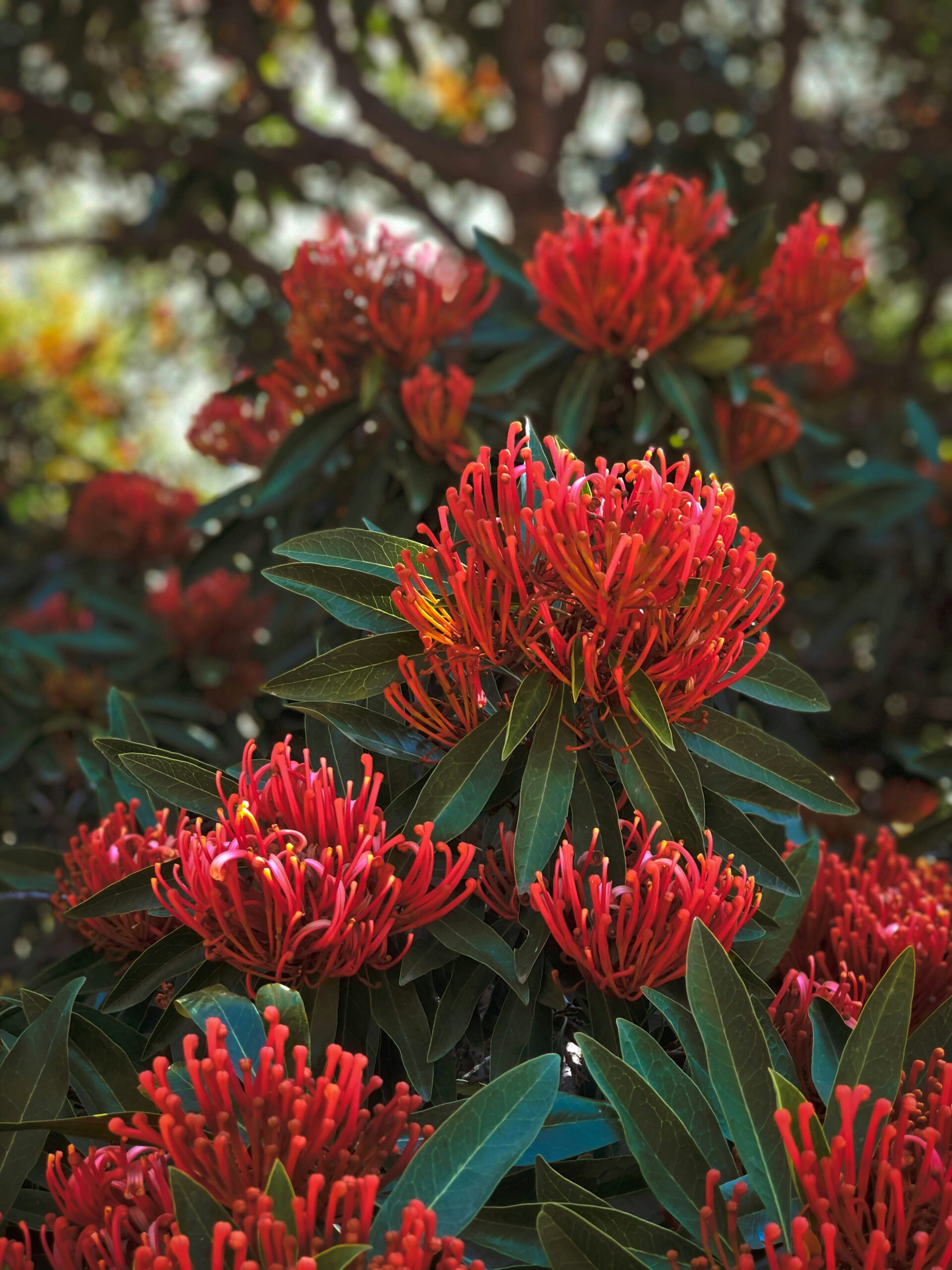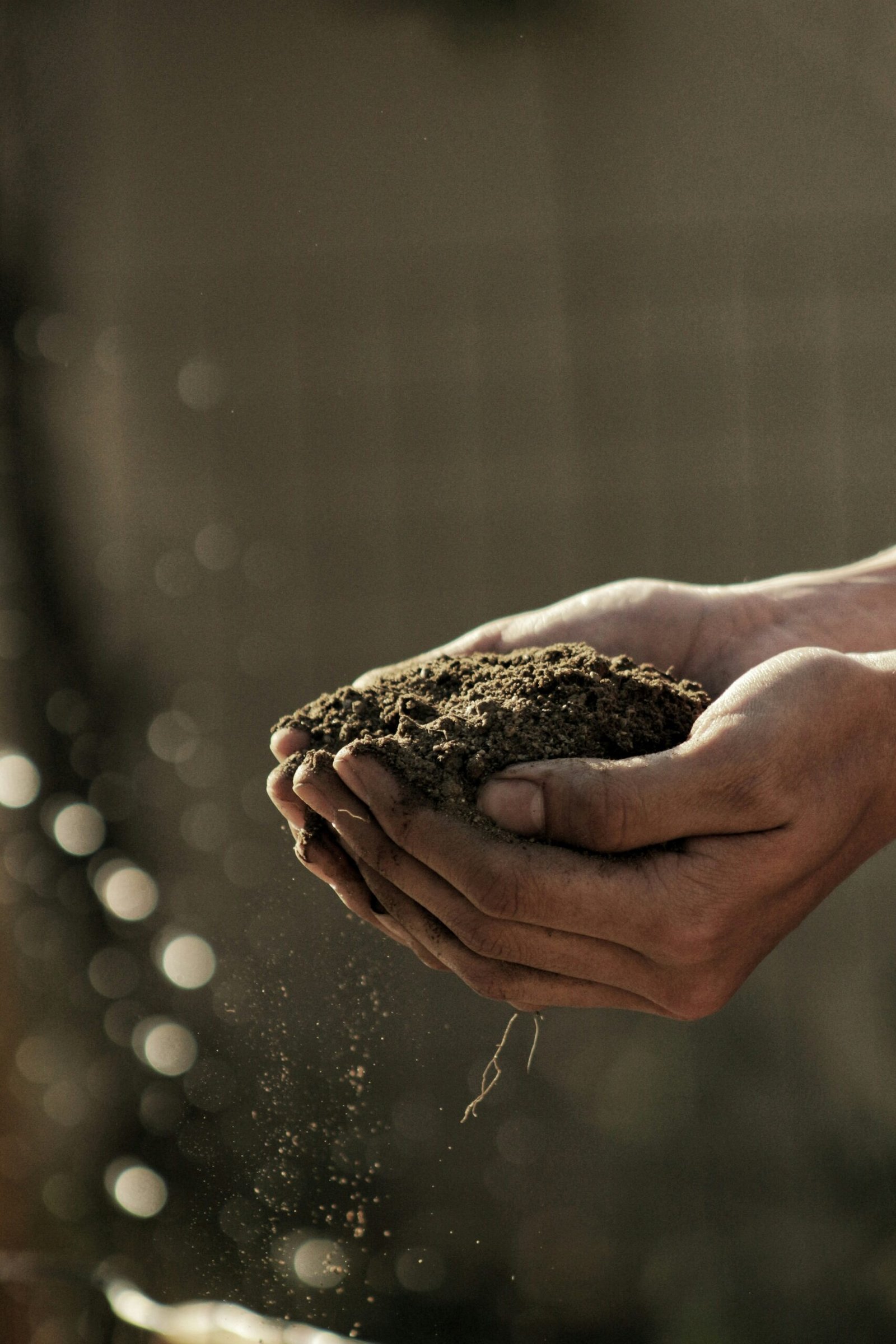Growing plants indoors, like orchids, can be rewarding, but it comes with challenges.
Key Takeaways
- Orchids face unique challenges when grown indoors
- Understanding orchid needs is key to keeping them alive inside
- Indoor plants may grow smaller but are easier to care for
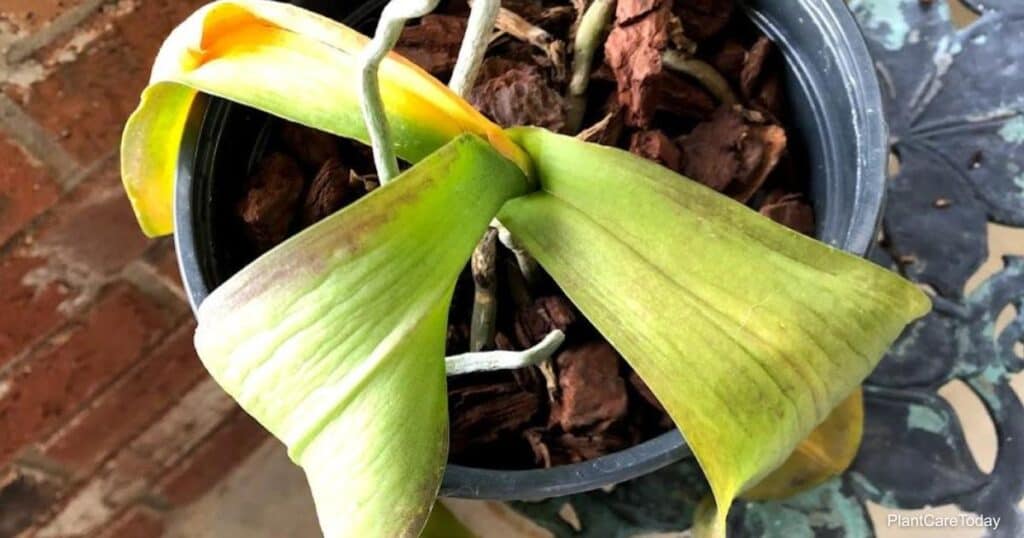
I’ve found that some plants, like pothos and philodendrons, don’t grow as big inside as they do in nature. They also might not flower as much. But the good news is I can grow them in any climate, and they’re easier to care for.
Orchids, especially moth orchids (Phalaenopsis), are becoming more popular as indoor plants. But some homeowners see their orchids die unexpectedly. This can happen because indoor conditions differ from what orchids are used to growing in the greenhouse or outside.
I think it’s important to understand these differences to keep orchids healthy inside.
Caring for Your Orchid
Orchids are special plants with unique needs. I’ll explain how to keep them happy and healthy.
Orchids often grow on trees in nature, not in soil. This means they need care that’s different from that of other houseplants. To help your orchid thrive, try to copy its natural home.
Here are the key things orchids need:
- Light: Bright light but not direct sun
- Water: Not too much, not too little
- Air: Good airflow around foliage and roots
- Temperature: Warm days, cooler nights
- Humidity: Moist air, but not wet leaves
I use a potting mix for orchids with excellent drainage that lets air reach the roots. Regular soil is too dense and can cause root rot.
This Premier Orchid Bark Potting Mix is perfect for orchids, offering excellent drainage to protect roots from rot. Made in the USA with the finest ingredients, it comes in a resealable 2-quart pouch. Perfect for repotting. Trusted by top conservatories, it’s a great gift and works with any orchid fertilizer.
If you click this link and make a purchase, we earn a commission at no additional cost to you.
Watering can be tricky. I check the roots before watering. If they’re silvery-white, it’s time to water. Green roots mean they have enough moisture.
Here’s a quick guide for watering:
- Use room temperature water
- Water in the morning
- Let the excess water drain out
- Don’t let the plant sit in the water
Orchids like warm days and cool nights. Most do well with daytime temps of 70-80°F and night temps of 60-70°F.
Humidity is important, too. I mist my orchids or use a humidity tray. But I’m careful not to get water on the leaves or flowers.
Fixing Your Struggling Orchid
I’ve seen many orchids face tough times, but there’s hope! Orchids can bounce back with the right care.
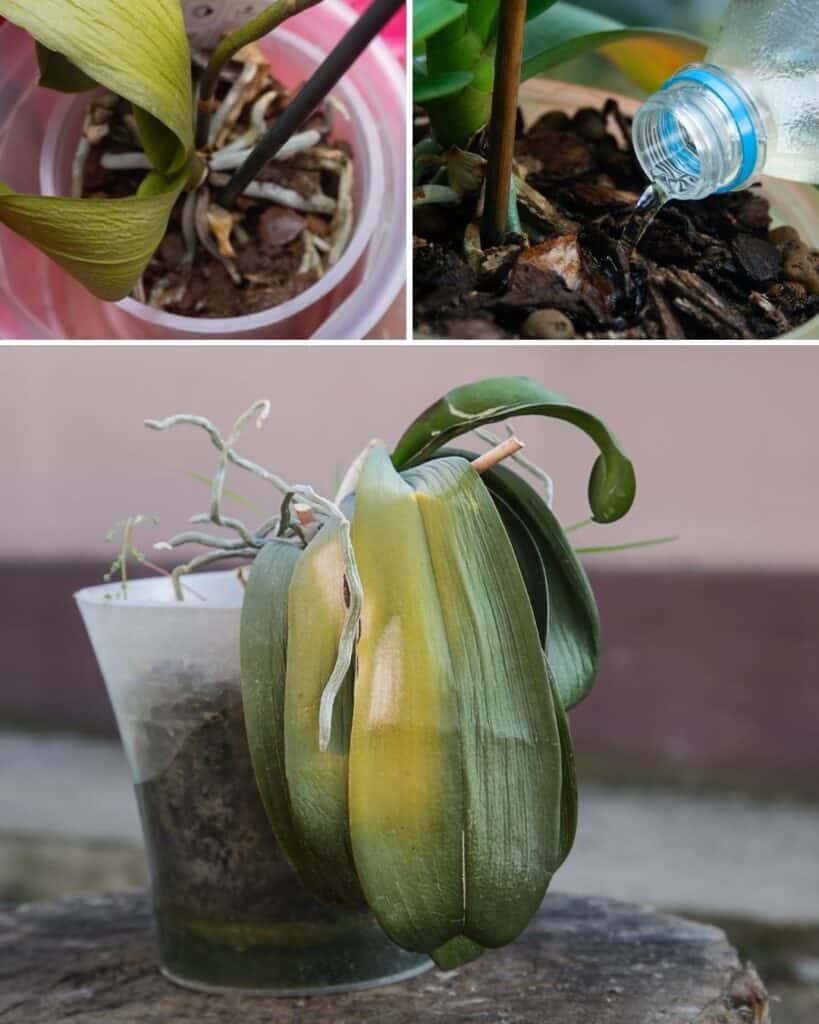

Here are some common issues I’ve noticed:
- Yellowing leaves
- Droopy or wilting stems
- Brown, mushy roots
- No new growth or flowers
These problems often stem from:
- Too much or too little water
- Poor light conditions
- Wrong temperature or humidity
- Nutrient imbalances
I’ll share some easy fixes to help your orchid thrive again. With some TLC, your plant can recover its beauty and health.
Watering Problems
Orchids can be tricky to water. I’ve seen many orchids suffer from both too much and too little water. Let’s look at the signs and solutions.
Think about the water quality you use. Water with many dissolved salts is not good for orchids, though most city water is fine. However, softened water with high sodium levels can be harmful.


Overwatering can cause yellowing leaves and mushy roots. I know it’s time to cut back if I notice these issues. On the flip side, wrinkled leaves and brittle roots often mean the plant is thirsty.
To fix watering issues, I follow these steps:
- Check the potting mix before watering
- Water thoroughly with tepid water in the morning. Allow the water to drain freely
- Empty the saucer to prevent standing water
My Watering Schedule
I like to water my orchids early in the morning when it’s cooler. A narrow-spouted watering can help me control the flow.
I normally water on Wednesday:
| Day | Watered? | Notes |
| Monday | NO | Still moist from Wednesday |
| Wednesday | YES | Medium slightly dry |
| Friday | NO | Still moist from Wednesday |
I’ve found a cool trick: I place my orchid pot on a tray with pebbles and water. This boosts humidity without soaking the roots.
Another tip is to learn how heavy the pot feels when it’s well-watered versus dry. This helps me know when it’s time to water again.
Fixing Rotten Orchid Roots
Root rot is a big problem for orchids. I’ll tell you how to spot it and fix it.
Bad roots look brown or black and feel mushy. You might smell something bad from the pot. Your orchid may droop even if you water it.
If you see these signs, act fast! Take the orchid out of its pot right away. Look at the roots closely.
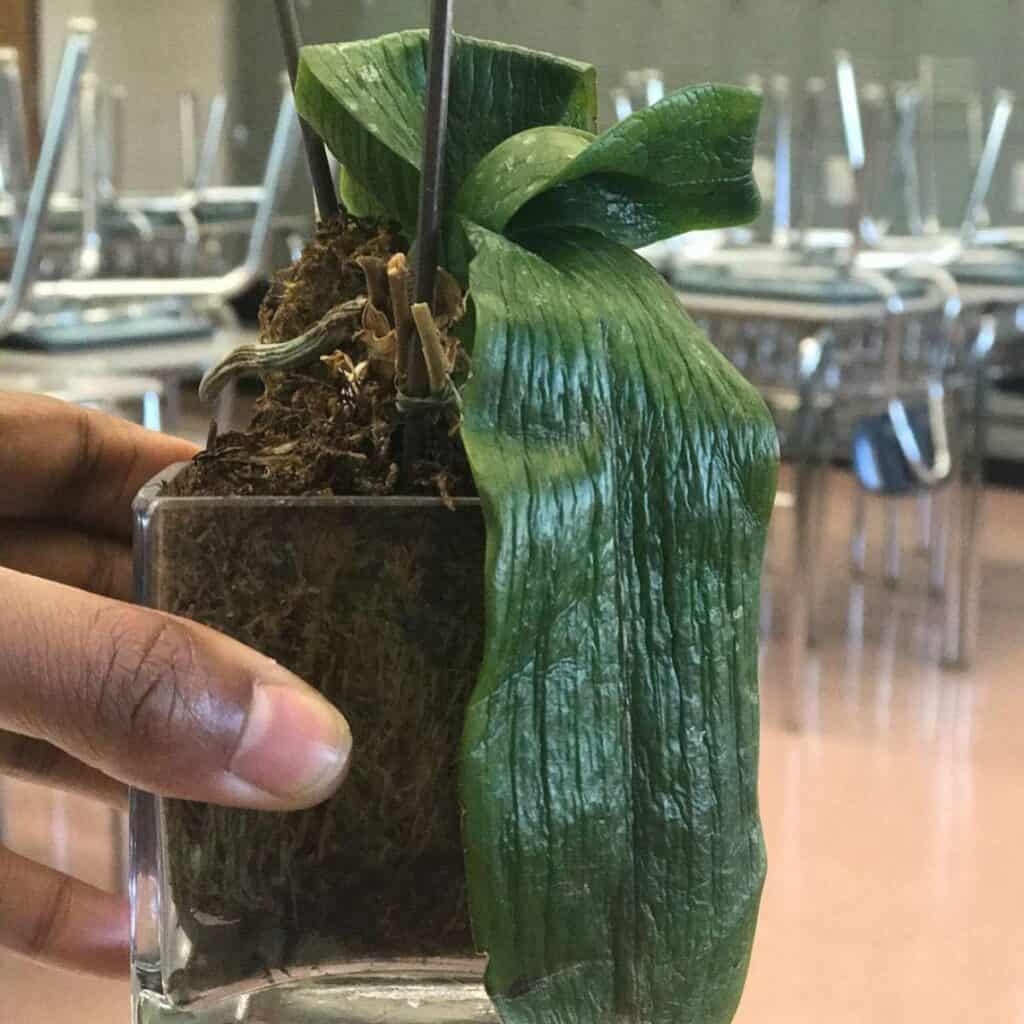

Cut off any rotten parts with clean scissors. I like to wipe my scissors with alcohol first.
It’s best to do this when it’s not too hot or cold. Aim for temps between 65°F and 85°F.
Here’s what I do:
- Gently take the plant out of its pot
- Rinse the roots with warm water
- Clean the scissors (I use a razor knife)
- Cutaway bad roots
- Put the orchid in fresh, well-draining orchid mix
After fixing the roots:
- Water less often
- Put the plant where air moves around it
I have two cool tricks:
- Sprinkle cinnamon on cut roots. It fights fungus!
- Make more holes in the pot. This lets air reach the roots better.
Using Hydrogen Peroxide:
For a fungal treatment, you can use 3% hydrogen peroxide to treat root and crown areas after trimming.
Spray the affected area and allow it to air dry before repotting. This helps eliminate any lingering fungal spores that may cause reinfection.
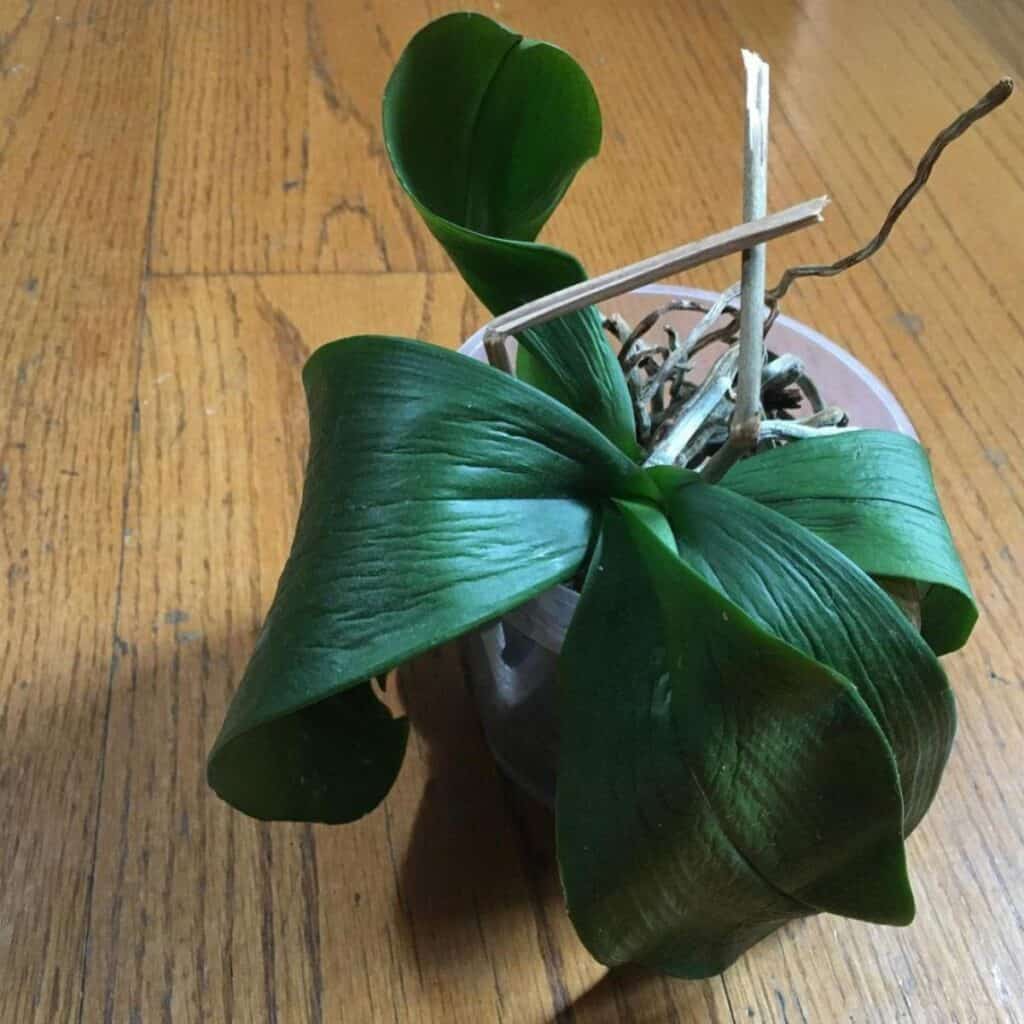

Fixing Rotten Crowns in Orchids
I’ve seen many orchids suffer from crown rot. It’s a tricky problem, but I can help you spot and fix it.
Crown rot often looks like this:
- Black or brown mush at the base of the plant
- Leaves that fall off too easily
- A soft, squishy stem area
When I notice these signs, I act fast. Here’s what I do:
- Dry out the crown right away
- Get more air moving around the plant
I tackle this issue as soon as I spot it. The plant does best when it’s warm – about 70-85°F.
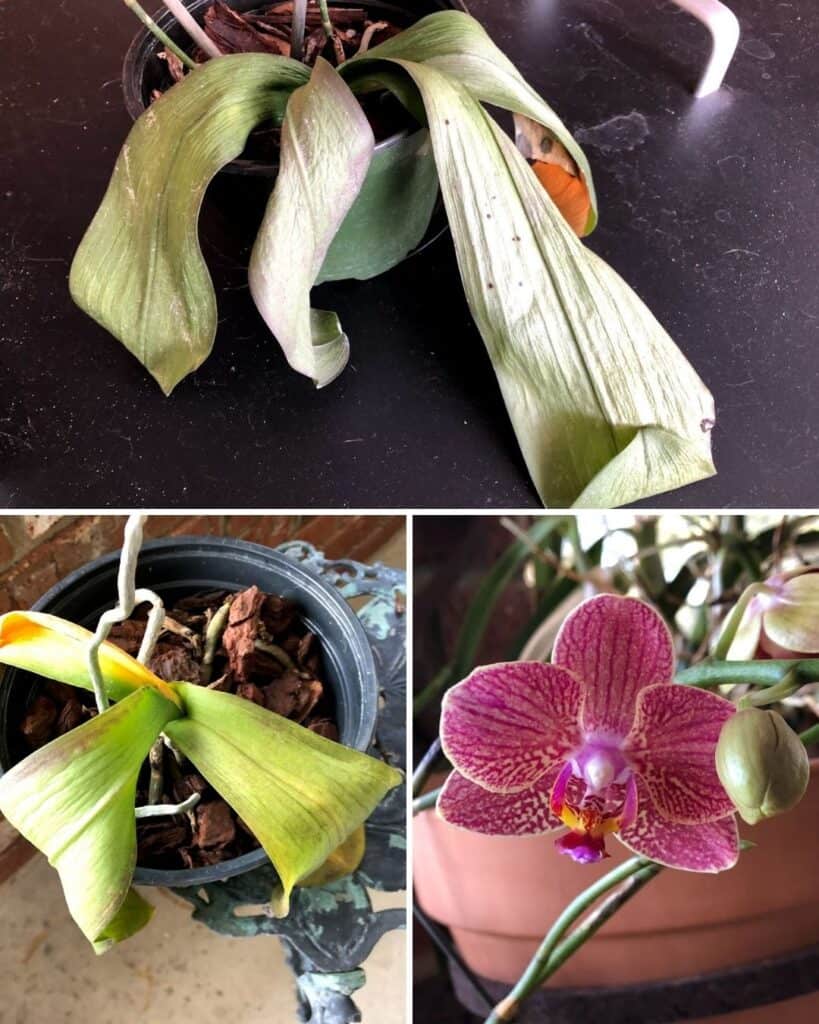

My go-to method:
- Tilt the orchid to let water drain out
- Cut away the yucky parts with clean tools
- Put some anti-fungus stuff on it
I also change how I water:
- No more watering from the top
- I water from the bottom instead
Some extra tips I’ve picked up:
- I put a cotton ball on top when watering to keep the crown dry
- Neem oil works great as a natural fix
Preventing Crown Rot:
To prevent crown rot, avoid watering the top of the orchid. Instead, water directly onto the potting medium or use bottom watering methods.
For extra protection, apply a light dusting of ground cinnamon or fungicide to the crown area, especially after any cutting or trimming.
Feeding Frenzy: When Orchids Get Too Much
Orchids can suffer from overeating. I’ve seen it happen. The signs are clear. Brown tips on leaves. Black edges. A crusty layer on top of the potting media. Leaves falling off for no reason.
What can you do? First, wash out the extra food. I run water through the pot for a few minutes. This gets rid of the buildup. Then, I changed how I feed my orchid.
When should you act? As soon as you see the signs. I like to do this when it’s not too hot or cold. Around 65°F to 75°F is best. This keeps the plant happy.
Here’s how I do it:
- Flushing:
- Use lukewarm water
- Let it run through for 3-5 minutes
- Make sure all the water drains out
- New feeding plan:
- Pick orchid food
- Use 1/4 of what the box says
- Only feed when the plant is growing
I’ve tried some cool tricks, too. Sometimes, I use worm tea instead of regular food. It’s gentler. Every fourth time I water, I skip the food. This stops buildup.
Fertilizer burns can really hurt orchids. But with care, you can fix it. Be patient and gentle. Your orchid will thank you.
Sun Damage on Orchids
Orchids can get hurt by too much sun. I’ve seen this happen to my own plants.
Let’s look at how to spot and fix this problem.
What does sun damage look like on orchids? You might see:
- White or yellow spots on leaves
- Dark patches that look sunken
- Dry, crispy leaf edges
These signs often show up fast after too much sun exposure.
If your orchid gets sunburned, act quickly! Here’s what to do:
- Move the plant to a shadier spot
- Keep it away from direct sunlight
- Find a place with bright but indirect light
The best spots for orchids are:
- Near east-facing windows
- Close to north-facing windows (if you’re in the Northern Hemisphere)
To protect your orchid from future sun damage:
- Hang sheer curtains over windows
- Use window blinds to filter light
- Put up shade cloth outside
I check my orchids daily to catch any issues early. If leaves start to look pale, I know it’s time to adjust their light.
Here are some cool tricks I’ve learned:
- Use a light meter app on your phone to measure brightness
- Move orchids around as seasons change – they might need different spots in summer vs. winter
Remember, orchids like it warm but not hot. Keep them between 65°F and 80°F (18°C to 27°C) for the best results.
Orchids Under Heat Stress
I’ve seen many orchids suffer from heat stress. It’s not pretty. The buds often fall off before they open. Leaves can get dark spots or turn yellow. Sometimes, the plant just stops growing or blooms late.
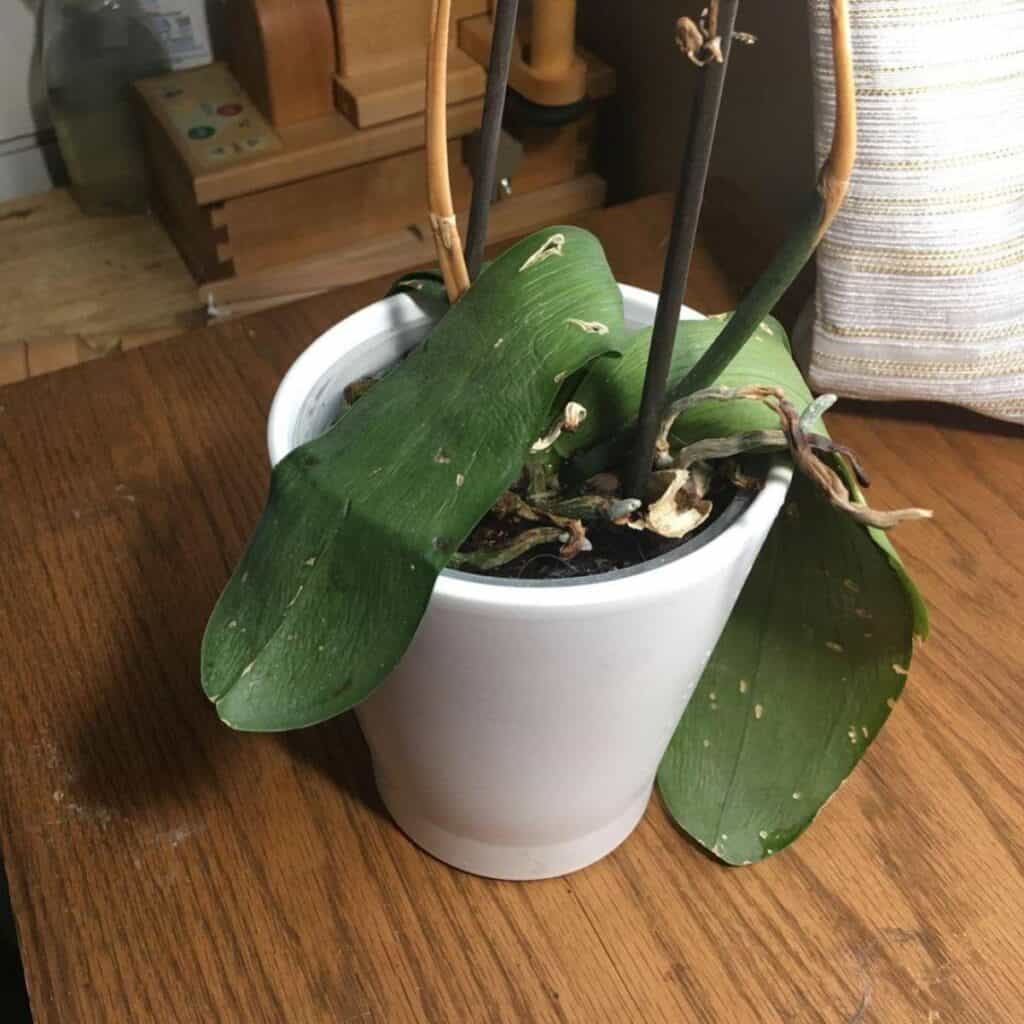

But don’t worry! There are ways to help your orchid.
First, keep the temperature steady. Orchids like it between 70°F and 85°F during the day. At night, they prefer 60°F to 70°F. I use a thermometer to check regularly.
Here’s what I do to protect my orchids:
- Move them away from drafty windows and doors
- Keep them off radiators or air conditioner vents
- Use a small fan for airflow, but not directly on the plants
- Group plants together to create a mini-humid zone
I’ve found that raising humidity helps a lot when it’s hot. A tray of water near the plants or a small humidifier works well.
If you’re serious about orchids, try keeping a temperature log. I write down the highs and lows each day. It helps me spot problems early.
Remember, orchids are sensitive to their environment. A little care goes a long way in keeping them happy and healthy.
Temperature Management Tips:
Orchids thrive in stable temperatures. Avoid sudden changes, as orchids are sensitive to temperature shocks. Protect them from air conditioning vents or heaters, and keep temperatures steady between 65°F and 80°F for best growth.”
Keeping Your Orchid Healthy and Happy
I check my orchids when watering to catch any problems early. This helps me spot signs of stress or disease before they get bad.
I make sure to use the right pot size and type for my orchids. This keeps their roots healthy and happy.
I always clean my tools before using them on orchids. It stops germs and viruses from spreading. I also keep the area around my orchids clean and tidy.
I like to learn more about caring for orchids and other plants whenever possible. I read books and join online groups to chat with other orchid lovers. This helps me take better care of my plants.
Here are some quick tips I follow:
- Water my orchids in the morning
- Give them bright but indirect light
- Use a special orchid potting mix
- Feed them with orchid food now and then
If you click this link and make a purchase, we earn a commission at no additional cost to you.
I find these steps help keep my orchids strong and less likely to get sick. If they do start to look sad, I know how to help them bounce back.
Final Thoughts on Orchid Revival
I’ve found that bringing an orchid back to life takes time and patience. Each plant is unique, so I adjust my approach based on its needs.
I always start by spotting early warning signs, like yellow leaves or droopy flowers. This helps me act fast.
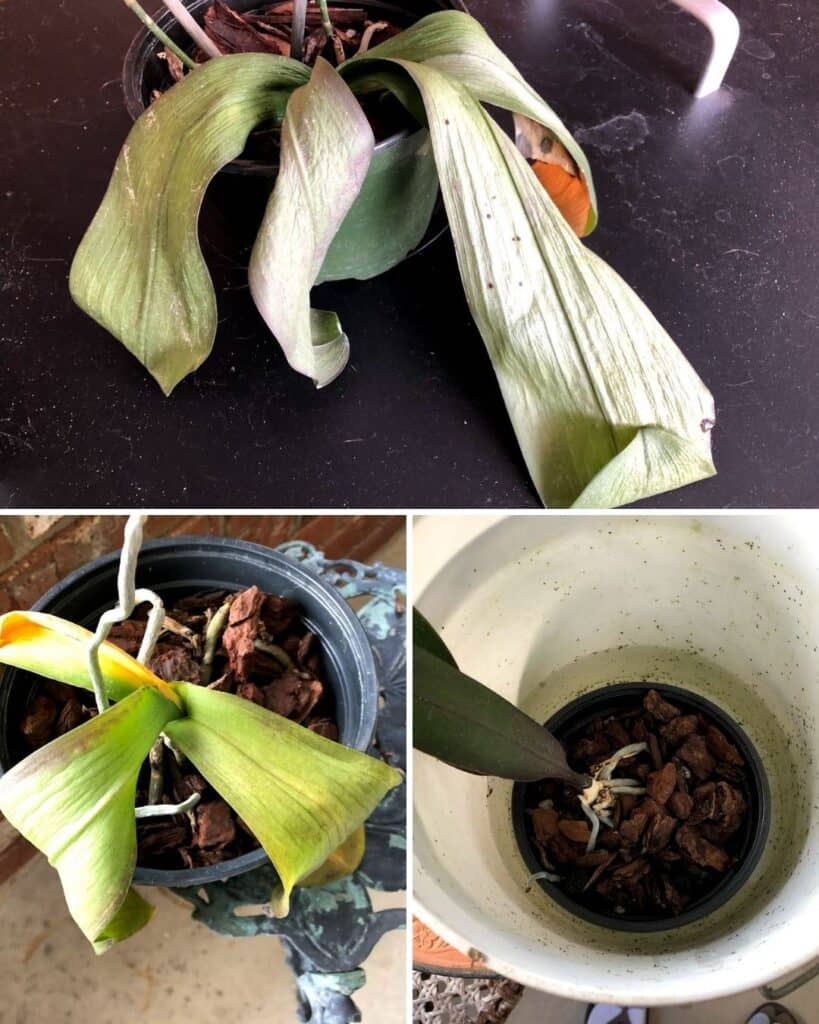

When I’m trying to save an orchid, I use these key steps:
- Check the roots
- Adjust watering
- Improve light conditions
- Repot if needed
I make sure to give my orchid a fresh orchid potting mix (lots of drainage). This helps prevent root rot.
I also place it near a bright window for indirect sunlight.
Consistency is important. I stick to a care routine that works for my specific orchid. This includes:
- Regular but careful watering
- Proper fertilizing
- Maintaining good humidity
I love seeing my orchids perk up after some extra care. Don’t give up if you’re trying to revive your own orchid! Try these tips and see what works best.
Every small step can make a big difference in returning your plant to health.


